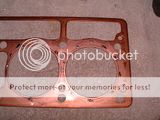I just started my TR4 engine (87mm pistons). I put it on an engine test stand. Started right up after I sealed the leak in the fuel pump. But the carburetors were having problems and while I was fixing that, I noticed the radiator overflow started to blow fluid. Number 3&4 cylinder were leaking into the water jacket. I had put on a COMETIC head gasket, made for the car (87-89mm). This gasket is about 20 thousands thinner than the copper usual. It also had a round cylinder ring vs the copper has one that follows the head shape. I could see impressions from the exhaust valves (scorch marks in the gasket and one place where it was leaking from the water jacket. Looks like air out to the water jacket, not water into the cylinder. There was NO white smoke, but lots of pressure in the radiator. The cylinders have set down into the block, not lower but not much protrusion. No water into the oil that I can see. I was looking for your opinions on trying the copper gasket back on the engine without tearing down the sleeves to check the figure of eight gaskets? Jerry TR3 with TR4 engine.
-
 Hi Guest!
Hi Guest!
You can help ensure that British Car Forum (BCF) continues to provide a great place to engage in the British car hobby! If you find BCF a beneficial community, please consider supporting our efforts with a subscription.
There are some perks with a member upgrade!**Upgrade Now**
(PS: Subscribers don't see this gawd-aweful banner

Tips
- We have a special forum called "Member Articles" where you can submit actual articles for consideration for publication. Learn More
- Don't have an Avatar? If not, your avatar will default to the 1st character in your username. Go into "Account Details" to change your Avatar.
- Some basic forum navigation info: click
Hey - did you know if you click on the title of a thread it will take you to the first unread post since you last visited that thread?
- Hey Guest - Is your British Car Club in our Clubs database? If not, send me a PM - Basil

- Looking for a local club? Click the "Clubs" tab above and browse hundreds of clubs world-wide.
- Add Android or iPhone APP: click
- Did you know - any picture or video you add in your posts in any marque-specific forum will also get added to the Media Gallery automatically.
- A few more tips about posting and replying: click
- Hey there Guest - be sure to keep your profile page up to date with interesting info about yourself: learn more
- More tips and tricks on Posting and Replying: click
 STOP!! Never post your email address in open forums. Bots can "harvest" your email! If you must share your email use a Private Message or use the
STOP!! Never post your email address in open forums. Bots can "harvest" your email! If you must share your email use a Private Message or use the  smilie in place of the real @
smilie in place of the real @
- Want to mention another member in a post & get their attention? WATCH THIS

- So, you created a "Group" here at BCF and would like to invite other members to join? Watch this!
- Hey Guest - A post a day keeps Basil from visiting you in the small hours and putting a bat up your nightdress!
- Hey Guest - do you know of an upcoming British car event?
 Pretty Please - add it to our Events forum(s) and add to the calendar! >> Here's How <<
Pretty Please - add it to our Events forum(s) and add to the calendar! >> Here's How << 
- Hey Guest - you be stylin'
Change the look and feel of the forum to fit your taste. Check it out
- If you run across an inappropriate post, for example a post that breaks our rules or looks like it might be spam, you can report the post to the moderators: Learn More
- If you would like to try some different "looks" or styles for the site, scroll to the very bottom, on the left and click the Style Selector.
You are using an out of date browser. It may not display this or other websites correctly.
You should upgrade or use an alternative browser.
You should upgrade or use an alternative browser.
Blown head gasket in 3 min. a new record!
- Thread starter Jerry
- Start date
TR3driver
Great Pumpkin - R.I.P
Offline
Check the liner protrusion on both sides. If not within the range given in the manual, and reasonably close together, then there is no way a standard gasket is going to seal for long, IMO.
However, this trick has worked for me for quite a few years now, on two different engines. Basically just a ring of .020" half-hard copper wire around each cylinder, next to the fold in the gasket. I used "electronic" solder, but I've heard that super glue works as well.


However, this trick has worked for me for quite a few years now, on two different engines. Basically just a ring of .020" half-hard copper wire around each cylinder, next to the fold in the gasket. I used "electronic" solder, but I've heard that super glue works as well.


TR3driver
Great Pumpkin - R.I.P
Offline
Stock gaskets crush to around .060" I believe.I thought Cometic was .043", about 10 thou thicker than stock.
I measured the Cometic gasket after it failed so I don't know how thick it was to start with. But I just put a copper gasket on and I could tell by the rocker arm adjustments that the copper is thicker. A little more adjusting tomorrow and I test the new gasket. I will let you guys know what happened.
Jerry
Jerry
I've got a 3A with 87mm pistons etc and I use a cheap Chinese CA gasket and copper FO8 liner seals and have never had any problems with either. There must be something wrong that needs sorting properly.
I'd look for cracks in the head, in the block face around the studs, especially around the one over the water pump and the two end ones on the distributor side. Then I'd check liner height and if in doubt, knock them out and start again with copper FO8s and Loctite 5699 gasket sealant around them.
These are not engines that have head gasket problems if they are correctly assembled.
I'd look for cracks in the head, in the block face around the studs, especially around the one over the water pump and the two end ones on the distributor side. Then I'd check liner height and if in doubt, knock them out and start again with copper FO8s and Loctite 5699 gasket sealant around them.
These are not engines that have head gasket problems if they are correctly assembled.
PatGalvin
Jedi Warrior
Offline
I've got a 3A with 87mm pistons etc and I use a cheap Chinese CA gasket and copper FO8 liner seals and have never had any problems with either. There must be something wrong that needs sorting properly.
Does anyone know who sells copper figure 8 gaskets? I have the steel ones from the Payden kit. Do copper seal better or are both styles fine?
Thanks for the helpful thread, guys.
pat
TR3driver
Great Pumpkin - R.I.P
Offline
I've used both kinds, never had any trouble with either. I believe the steel ones are supposed to have a plastic/latex coating on them that helps them seal, but I add Permatex anyway.Do copper seal better or are both styles fine?
I did fight head gasket problems for a lot of years, but it turned out to be that the block was not machined properly at the factory. The right solution would have been to have the block decked to the right height (above the liner seats), but the copper wire trick has worked great ever since I realized what the issue was.
Likely it's just coincidence that two (early) blocks in a row were mis-machined; but I have to think it was a fairly common problem. First one was TS11xxx, second was TS15xxx.
Dont go into shock but VB sells a kit with the copper 8 seals.If you replace liners and fail to have the
block checked for the correct height of the sleeves you run a real risk of trouble.The liners should be
dead flush BEFORE the 8 seals are installed,they provide the proper crush for the head gasket....
MD(mad dog)
block checked for the correct height of the sleeves you run a real risk of trouble.The liners should be
dead flush BEFORE the 8 seals are installed,they provide the proper crush for the head gasket....
MD(mad dog)
TR3driver
Great Pumpkin - R.I.P
Offline
The liners should be dead flush BEFORE the 8 seals are installed,
Is that your final answer? Are you really trying to claim that the Fig 8 seals are only .005" thick?
PatGalvin
Jedi Warrior
Offline
Hey Randall
Do you have an opinion of how to measure the sleeve distance above the block deck? Do you seat liners and just tap down with rubber mallet? Or torque down head and then remove and measure distance sleeves sit above block deck? Basically, how much pressure to apply to sleeves to seat them in block prior to measurement?
Do you have an opinion of how to measure the sleeve distance above the block deck? Do you seat liners and just tap down with rubber mallet? Or torque down head and then remove and measure distance sleeves sit above block deck? Basically, how much pressure to apply to sleeves to seat them in block prior to measurement?
TR3driver
Great Pumpkin - R.I.P
Offline
I tried both methods and didn't see much difference. At least for me, it doesn't seem that the Fig 8 gaskets permanently deform and the liners should move easily in the block. So now I just tap them down and measure. If they were too high the first time, I might try torquing the head down (without a head gasket), but that hasn't happened yet.

